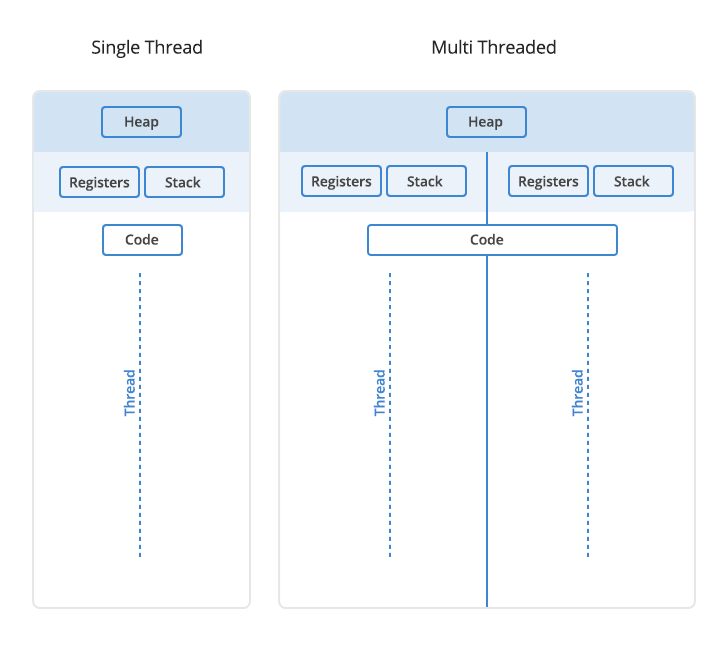Thread - Definition, run()&start(), main
Thread
Definitions : Process and Thread
Process is simply a ‘program in execution’. When a program is executed, OS allocates appropriate resources(memory) to the program, making it a process.
Thread is an actual executing module functioning within a process.
Process = Threads + Resources (Data + Memory)
- Threads share the same address space and therefore can share both data and code
- Context switching between threads is usually less expensive than between processes
- Cost of thread intercommunication is relatively low that that of process intercommunication Threads allow different tasks to be performed concurrently.
Single & Multi Thread
CPU core performs one task at a time; hence, the number of concurrently processed task is equal to the number of CPUs. Because the former is almost always greater than the latter, CPU works by switching from one thread to the other at an amazingly fast speed.
 #####Is Multi-Threading always better?
#####Is Multi-Threading always better?
- No. If threads use same resources to perform a task, there is a computation overhead of switching between contexts.
- Multi threading is especially effective when threads use different resources. For example, user I/O task and file transfer via network can be benefited from using multi threading.
Creating a new Thread
Creating a thread is not difficult. You can either create it by extending Thread class or implementing a Runnable interface. Using Runnable interface is preferred because, once inheriting from Thread class the inheriting class cannot inherit other classes.
public class Thread1 {
public static void main(String[] args) {
ThreadEx t1 = new ThreadEx(); //Thread creation by inheriting Thread class
Runnable r = new ThreadRn(); //Thread creation by implementing Runnable interface
Thread t2 = new Thread(r);
//Thread t2 = new Thread(new ThreadRn()) also works
t1.start();
t2.start();
}
}
public class ThreadEx extends Thread {
public void run(){
System.out.println("Hello, I'm thread 1!");
}
}
public class ThreadRn implements Runnable{
@Override
public void run() {
System.out.println("Hello, I'm thread 2!");
}
}
Console Output
Hello, I'm thread 1!
Hello, I'm thread 2!
start( ) , run( ), Main Thread
The above code called start(), not run(). Why?
- start() method creates a call stack necessary for a thread to execute its task.
- Once a call stack is made, run() is loaded onto it.
- Whenever a new thread is created or deleted, a call stack is also created or deleted.
- Below example demonstrates the difference between calling a start() method and calling a run() method.
public class Thread2 {
public static void main(String[] args) {
ThreadRun t1 = new ThreadRun();
t1.start(); //Thread called start,
}
}
public class ThreadRun extends Thread {
public void run(){
throwException();
}
private void throwException(){
try {
throw new Exception();
} catch (Exception e) {
e.printStackTrace();
}
}
}
Console Output
java.lang.Exception
at Thread.Thread2.ThreadRun.throwException(ThreadRun.java:10)
at Thread.Thread2.ThreadRun.run(ThreadRun.java:6)
- Note that the error was NOT thrown in main. This is because the error was thrown in a different call stack, one that is claimed by ‘start()’ in the main method.
public class Thread2 {
public static void main(String[] args) {
ThreadRun t1 = new ThreadRun();
t1.run(); //Thread is run from the Main stack, not from a new stack
}
}
Console Output
java.lang.Exception
at Thread.Thread2.ThreadRun.throwException(ThreadRun.java:10)
at Thread.Thread2.ThreadRun.run(ThreadRun.java:6)
at Thread.Thread2.Thread2.main(Thread2.java:6)
As can be expected, the error stack includes main this time.